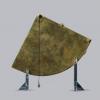Luis de Camoens, The Lusiad (London, 1655)
External links
Commentary
The Lusiad is an epic poem, describing in a fantastical way the story of Vasco da Gama’s (1460/1469-1524) voyage to India around the Cape of Good Hope in 1497-98. It was first published in Portuguese in 1572 as Os Lusiads, before being translated into English by Sir Richard Fanshawe.
It closely mimics the style, structure, content and layout of Virgil’s Aeneid. The first line mimics Virgil’s, and it features a number of figures from Roman mythology, such as Venus, who helps the Portuguese, and Bacchus, who opposes them. The majority of the work is narrated by Vasco da Gama, who is often referred to as “eloquent captain”. The other narrators include Vasco’s older brother, Paulo, Thetis, the mother of Achilles, and a Siren, Tethys, who becomes Vasco’s lover. Like the Aeneid, it is divided into 10 sections, or cantos. The last canto is told by Tethys, and narrates the future of Portuguese exploration and conquest of the first half of the sixteenth century. Its name is derived from the fact that, just as the Aeneid sings of Aeneas, the Lusiad sings of the Lusiadas, or the sons of Lusus, the mythical father of modern Portugal.
Canto III and IV narrate the history of Portugal. This includes such major events as the conquest of Ceuta in 1415, shown in the third image in the gallery, led by Henry the Navigator (1394-1460), son of John I of Portugal (ruled 1385-1433). He was a pioneer of Portuguese exploration, and so it is only fitting that this celebration of Portuguese exploration takes time to honour him.
The Lusiad is often cited as being the most important work of literature in the Portuguese language. It shows how the early explorers were revered almost as gods and the great heroes of the ancient world, and how accounts of epic journeys such as this one can be exaggerated.


